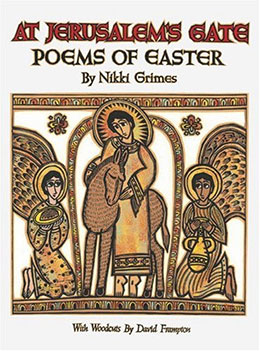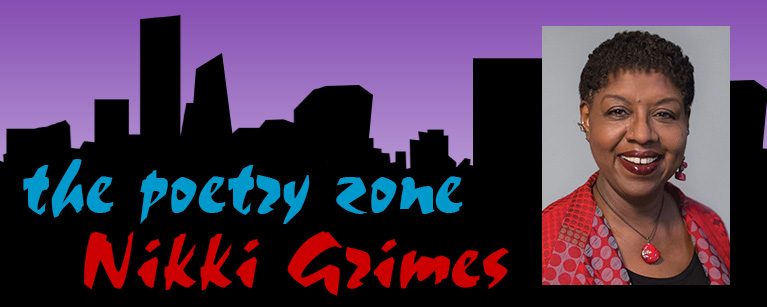
Buy this book:
written by Nikki Grimes
illustrated with woodcuts by
David Frampton
Eerdman Books for Young Readers, 2005
hardcover
At Jerusalem’s Gate: Poems of Easter
From the Book
“From A Distance”
The shadow of the thing
was all I saw,
the crosses, three, a blot
against the sky.
I stood far off, awash
in tears and shame,
angry with him—who else
was there to blame?
His promised kingdom seemed
a dream stillborn,
tht world in which he’d rule
in peace and light.
For there on Calvary
within my sight
all hope was pierced with him
upon the cross.
What could I do but weep,
for all was lost.
from At Jerusalem’s Gate
© 2005 by Nikki Grimes
About the Book
A man in the crowd at Jerusalem vies to see Jesus; a disciple recounts details of the Last Supper; Pilate’s wife fears her husband’s decision. Beginning with Christ’s triumphant arrival in Jerusalem, Nikki Grimes explores the first Easter through the voices of those who witnessed it.
The author’s introductions provide a thoughtful framework, and David Frampton’s beautifully intricate and expressive woodcuts illuminate each poem. At Jerusalem’s Gate offers readers of all ages insight into the most important moments in Christian history.
Awards and Recognition
- Cleveland Public Library Best Books of 2005
Resources
Reviews
Through beautiful, lucid free verse, Nikki Grimes explores some of the ambiguous, enigmatic events and circumstances leading up to the central theme behind the annual Easter observance. Twenty-two poems introduced by a brief explanatory paragraph portray the story through the imagined eyes of the principals involved. Details of the Last Supper, Pilate’s wife’s role, the religious council tribunal, Mary’s grief, the darkening of the sky at the time of the crucifixion and the site of the ascension are all included. Questions raised in each piece encourage discussion of multiple interpretations, as in the poem titled “What’s in a Name?,” which refers to Judas’s role as one of betrayer and the subsequent altered implication to his name. Poetry is gentle yet thoughtful, alluding to the brutality of the execution while providing an almost prayer-like personal reflection. Multi-colored woodcuts suggest the emotion and mood of each scene in a parody of stained glass. A handsome, well-designed offering for middle readers and families. (Kirkus Reviews, starred review)


